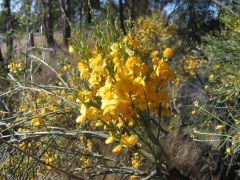Native broom facts for kids
Quick facts for kids Native broom |
|
|---|---|
 |
|
| Viminaria juncea | |
| Scientific classification | |
| Kingdom: | |
| (unranked): | |
| (unranked): | |
| (unranked): | |
| Order: | |
| Family: | |
| Subfamily: | |
| (unranked): | |
| Genus: |
Viminaria
Sm.
|
| Species: |
V. juncea
|
| Binomial name | |
| Viminaria juncea (Schrad.) Hoffmanns.
|
|
The Viminaria juncea is a special plant found only in Australia. It is the only type of plant in its group, called Viminaria. This plant belongs to the pea family, known as Fabaceae. People often call it native broom because it looks a lot like the broom plants found in Europe. The Noongar people, who are Indigenous Australians, have their own name for this plant: koweda.
Contents
About the Native Broom Plant
This plant was first described in 1795 by a scientist named Heinrich Adolph Schrader. He first called it Sophora juncea. Later, in 1824, another scientist named Johann Centurius Hoffmannsegg gave it its current scientific name, Viminaria juncea.
What Its Name Means
The name Viminaria comes from a Latin word, vimineus, which means "switch". This refers to its long, thin branches. The second part of its name, juncea, also comes from Latin, meaning "rush-like". So, Viminaria juncea means "rush-like switch plant". You might also hear it called golden spray, native broom, or swishbush.
What Native Broom Looks Like
Native broom is a shrub that can grow quite tall. It can be anywhere from 1.5 to 6 meters (about 5 to 20 feet) high. It can also spread out from 1 to 2.5 meters (about 3 to 8 feet) wide. It has a smooth main stem and branches that grow upwards. Its smaller branches often hang down, giving it a graceful look.
Leaves and Flowers
The leaves of the native broom are long and thin. They can be from 3 to 25 centimeters (about 1 to 10 inches) long. The plant blooms, or flowers, from September to January. Its flowers grow on long stalks called racemes, which can be about 25 centimeters (10 inches) long. Each flower is about 0.8 centimeters (0.3 inches) across. They are bright yellow with an orange center and look like typical pea flowers. After the flowers, small pods grow, and each pod usually holds just one seed.
Where Native Broom Grows
This plant likes to grow in wet, swampy areas close to the coast. You can find it across southern Australia. This includes places from near Geraldton in Western Australia down to Esperance. In eastern Australia, it grows in coastal areas of Queensland, New South Wales, Victoria, and South Australia.
Growing Native Broom in Gardens
Native broom grows quickly in a garden. However, it might start to lose its strength after about 5 to 10 years. It prefers soil that is a bit acidic to neutral, and it needs plenty of water. This plant is quite tough and can handle cold temperatures down to about -4 °C (25 °F). Plants grown from seeds are usually stronger than those grown from cuttings (pieces of the plant).
See also
 In Spanish: Viminaria para niños
In Spanish: Viminaria para niños

